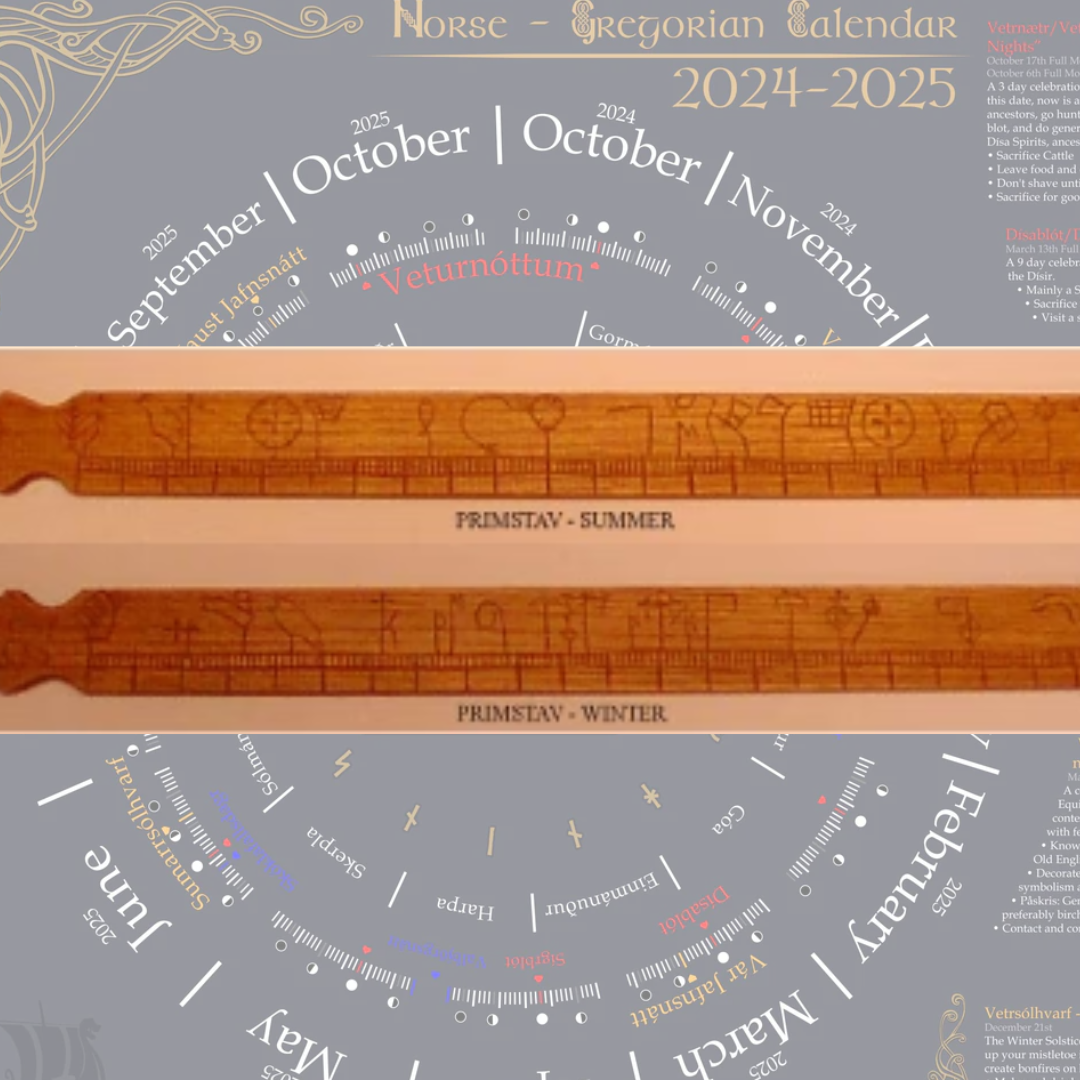
What was the Norse Calendar?
Share
What We Know About the Norse Calendar
We do not have a preserved Norse calendar from the Viking Age in either archaeology or written records. However, by analyzing Norse and broader Germanic sources, we can reconstruct a highly accurate Norse pagan calendar, including the dates of major Asatru blot festivals and pagan holidays. This reconstruction provides insight into how the Norse likely organized their year and celebrated their sacred traditions.
This article is as an short overview of the sources used to reconstruct the Norse calendar. You can find a detailed breakdown of each holiday and its historical context in our full article on the subject.
See the full article HERE
Our calendar for sale HERE
The Primstav: A Pagan Calendar Stick
By far, the most tangible remnant of Norse timekeeping is the primstav, a Norwegian calendar stick found in multiple archeological digs with the earliest ones dating back to the 13th century. While this is after the Viking Age, the primstav has many clear pagan roots, as many of its carved symbols align with seasonal festivals celebrated in Norse tradition. It served as both a practical and symbolic tool, marking important agricultural and religious dates, offering a rare glimpse into the structure of the Norse pagan calendar.

The Icelandic Month Names
Another valuable source is the Icelandic month names recorded after the Viking Age. These names are thought to be partially or fully identical to those used during the Viking period. The names reflect the agricultural and natural cycles of the year, tying closely to Norse life and celebrations.
- Harpa (mid-April to mid-May)
- Skerpla (mid-May to mid-June)
- Sólmánuður (mid-June to mid-July)
- Heyannir (mid-July to mid-August)
- Tvímánuður (mid-August to mid-September)
- Haustmánuður (mid-September to mid-October)
- Gormánuður (mid-October to mid-November)
- Ýlir (mid-November to mid-December)
- Mörsugur (mid-December to mid-January)
- Þorri (mid-January to mid-February)
- Góa (mid-February to mid-March)
- Einmánuður (mid-March to mid-April)
Pagan Holidays in the Norse Sagas
The Norse sagas, written between the 13th and 15th centuries and accounting much older events in pagan times, are an invaluable source for reconstructing the Norse pagan calendar. These texts reference holidays like Vetrnaetr, Yule, and Sigrblót with very clear consistency. Attested hundreds, if not thousands, of times, these sagas detail the timing and practices of these sacred days, allowing us to reconstruct when and how these celebrations occurred in pagan times.
"Odin established the same law in his land that had been in force in Asaland. {....}. On winter day there should be blood-sacrifice for a good year, and in the middle of winter for a good crop; and the third sacrifice should be on summer day, for victory in battle."
-Ynglinga Saga, ch.8
Other Medieval Sources on Germanic Calendars
Medieval chroniclers, such as Adam of Bremen, Thietmar of Merseburg, Ibn Fadlan and al-Tartushi provide first-hand accounts of Viking pagan celebrations. These writings offer a detailed look at the rituals, sacrifices, and assemblies held on Norse pagan holidays. For example, Adam of Bremen described midwinter sacrifices at Uppsala, and Thietmar recorded a nine-year cycle for major celebrations in Viking Denmark. These first hand accounts are of course the most reliable and should be prioritized above other sources when reconstructing that actual practices of the norse holidays.
"Because I have heard strange stories about their ancient sacrifices, I will not allow the practice to go unmentioned. In those parts the center of the kingdom is called Lederun (Lejre), in the region of Selon (Sjælland), all the people gathered every nine years in January, that is after we have celebrated the birth of the Lord [Jan 6th], and there they offered to the gods ninety-nine men and just as many horses, along with dogs and cocks— the later being used in place of hawks."
-The Chronicon of Thietmar of Merseburg, 10th century
Bede: A Key Source on Germanic Calendars
Bede’s The Reckoning of Time is the most detailed written source on pre-Christian Germanic calendars. Although focused on the Anglo-Saxons, this work provides essential insights into the structure of the year, the seasons, and pagan festivals. The Anglo-Saxon months described by Bede often correspond to Norse traditions, such as Yule (Geola) and other agricultural-based celebrations, illustrating shared cultural patterns across Germanic peoples.
"Thus, the moon by which they began their winter season was called “Winterfylleth”, a name compounded of the terms for winter and full moon, because from the full moon of that moon winter was thought to begin."
-Bede, De Temporum Ratione 8th century
Earlier Germanic Sources
Earlier Germanic texts, such as Tacitus’ Germania, Julius Caesar’s De Bello Gallico, and Jordanes’ Getica, provide additional context for how Germanic tribes understood time, seasons, and festivals. These sources, along with works by Procopius and early Gothic writings, reveal consistent themes—such as solstice and equinox celebrations very often consistent with what we find in later Norse saga accounts of pagan calendar traditions.
"Affairs of smaller moment the chiefs determine: about matters of higher consequence the whole nation deliberates; yet in such sort, that whatever depends upon the pleasure and decision of the people, is examined and discussed by the chiefs. Where no accident or emergency intervenes, they assemble upon stated days, either, when the moon changes, or is full: since they believe such seasons to be the most fortunate for beginning all transactions. Neither in reckoning of time do they count, like us, the number of days but that of nights."
-Tacitus, Germania 1st century
Conclusion: Reconstructing the Norse Calendar
By examining a wide array of sources, including sagas, historical accounts, and archaeological finds, we can reconstruct a remarkably accurate Norse pagan calendar. While no single calendar from the Viking Age has survived, the consistency of evidence across Norse and broader Germanic traditions gives us a detailed understanding of the holidays and timekeeping methods likely observed in pagan times. This reconstructed calendar is a testament to the cultural importance of the seasons, nature, and spiritual practices in Norse society.
